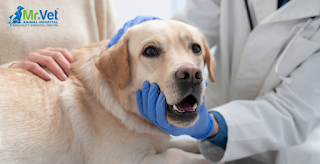Key Early Warning Signs of Cancer in Dogs Every Pet Owner Should Know
 |
| Scabies in Dogs |
Cancer in dogs is a significant concern for pet owners, especially as it is one of the leading causes of death in older dogs. However, with early detection, many cancers can be treated or managed, offering your dog a better chance at a longer and healthier life. Recognizing the early warning signs of cancer is crucial for timely intervention. This guide will help you understand the key symptoms of cancer in dogs and the necessary steps to take if you observe any of these signs.
Early Warning Signs of Cancer in Dogs
1. Lumps and Bumps
One of the most noticeable early signs of cancer in dogs is the development of lumps or bumps on their body. While not all lumps are cancerous, any new growth or an existing lump that changes in size, shape, or texture should be examined by a veterinarian. Cancerous tumors typically grow quickly and may have an irregular shape or feel. Regularly checking your dog for lumps during grooming can help you catch these changes early.
2. Unexplained Weight Loss
A sudden, unexplained loss of weight in your dog can be a red flag for cancer. Although weight loss can occur due to other health issues like digestive problems or dental pain, cancer can also be a culprit. If your dog is eating normally but continues to lose weight, it’s time to schedule a vet appointment for further examination.
3. Loss of Appetite
A drop in appetite or complete refusal to eat can indicate various health problems, including cancer. Certain types of cancer can cause nausea, pain, or discomfort, leading to a loss of interest in food. If your dog’s appetite doesn’t return to normal within a day or two, it’s important to consult with a veterinarian to rule out cancer or other serious conditions.
4. Lethargy and Fatigue
Is your dog more tired than usual, even with sufficient rest? Lethargy and fatigue can be symptoms of cancer, particularly if your dog seems uninterested in activities they usually enjoy, like playing, going for walks, or interacting with family members. While lethargy can result from other conditions, it’s important not to dismiss it, especially if it persists.
5. Persistent Coughing or Difficulty Breathing
Coughing or difficulty breathing may be signs of lung cancer or a tumor pressing on the lungs. While these symptoms could also be related to respiratory infections or allergies, they shouldn’t be ignored if they persist. A vet evaluation is essential to identify the underlying cause.
6. Sores That Don’t Heal
Sores or wounds that don’t heal, or take too long to close up, may indicate skin cancer. Particularly in areas exposed to sunlight, persistent sores should be examined. Slow-healing wounds can also suggest a weakened immune system, which could be linked to cancer or other internal issues.
7. Changes in Bathroom Habits
Changes in urination or defecation habits, such as difficulty urinating, or the presence of blood in the urine or stool, can indicate cancers in the bladder or gastrointestinal tract. Monitoring these changes closely and seeking veterinary advice is crucial for early diagnosis.
8. Difficulty Swallowing or Eating
Tumors in the mouth, throat, or neck can cause difficulty chewing or swallowing. If your dog struggles with eating, drools excessively, or avoids food due to discomfort, this could be a sign of an oral tumor. Early detection of these tumors can prevent more serious complications.
9. Abnormal Odors
Unusual and strong odors from your dog’s mouth, ears, or any other part of the body may indicate cancer. Bad breath is often associated with dental issues, but in some cases, it may signal oral cancer. If the smell doesn’t improve after dental cleaning or treatment, further testing is needed.
10. Swelling or Unusual Discharges
Swelling in any part of your dog’s body, particularly the abdomen or limbs, could be a sign of cancer. Additionally, abnormal discharges from the nose, eyes, or any other body parts should be checked by a vet, as they may be indicators of tumors or infections.
What to Do If You Suspect Cancer in Your Dog
If your dog is exhibiting any of the symptoms mentioned above, the most important step is to consult a veterinarian immediately. Early diagnosis through tests such as blood work, imaging (X-rays or ultrasounds), or biopsies can help determine whether your dog has cancer and what type it is. Treatment options vary depending on the type of cancer but may include surgery, chemotherapy, radiation, or medication.
Conclusion
Cancer in dogs can be a frightening prospect for any pet owner, but early detection can significantly improve your dog’s chances of recovery. By staying vigilant and paying attention to changes in your dog’s health and behavior, you can catch early warning signs and take action swiftly. Regular veterinary check-ups are essential in maintaining your dog’s health and catching any abnormalities in time.
At MrVet Hospitals, we are dedicated to providing the best care for your pets, from diagnosis to treatment. By understanding the early signs of cancer in dogs, you can help ensure your furry friend stays happy and healthy for years to come.


Comments
Post a Comment